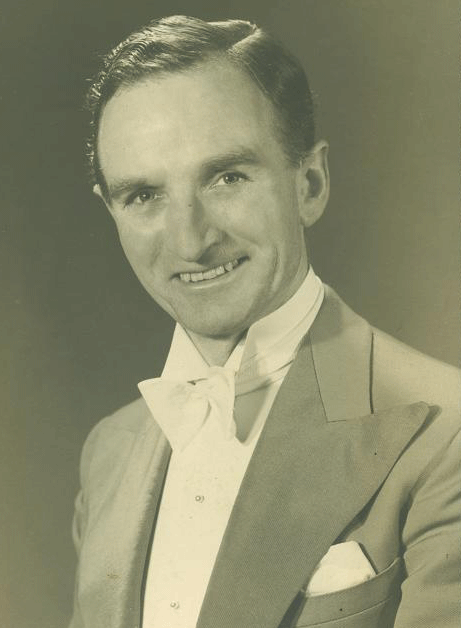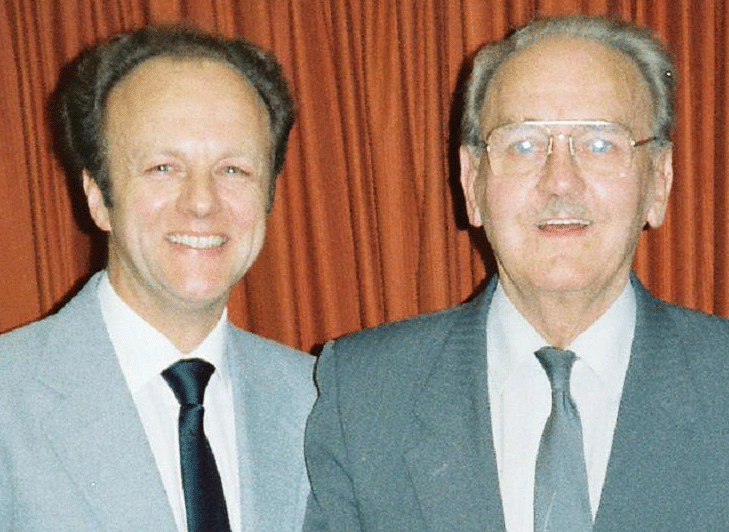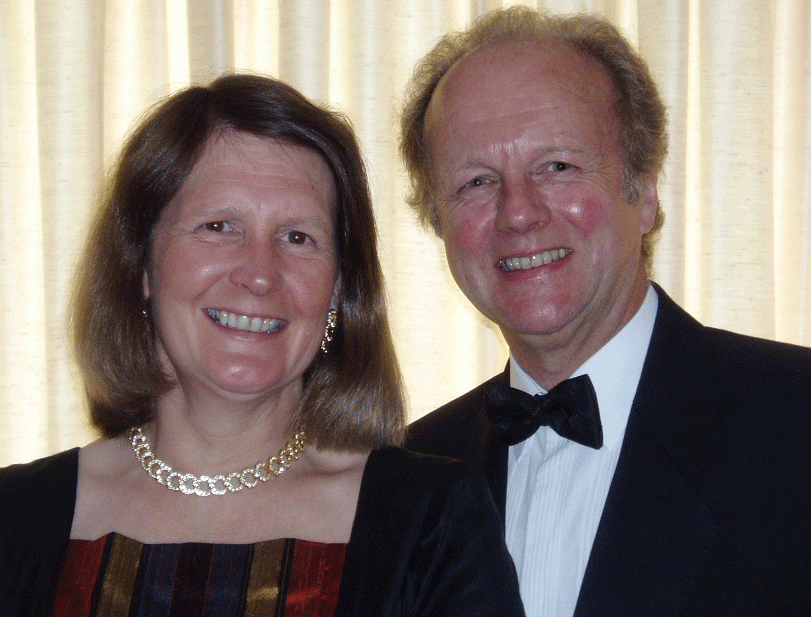In February 2009 what is now known as The Brockbank-Lane Sequence Script Service enters its 60th year of publication. It was in the late 1930’s that A J Latimer of the BBC radio programme “Those Were The Days” issued a book on old time dancing entitled “Bouquest of Old Time Dances”. The Official Board of Ballroom Dancing, Old Time Sub-committee also issued a booklet on Old Time Dances. Mr John E Evans, a teacher of dancing who resided in Wales, was already circulating scripts of existing dances to a few of his teaching friends in the form of a “letter service”, the value of which was seen by Michael Gwynne of Bournemouth. On the death of John Evans, Michael arranged to continue the service and in 1949 The Michael Gwynne Letter Service was born.
The book issued by A J Latimer contained the copies of dances printed on the back of sheet music, nearly all published by Francis, Day and Hunter. Details of the dances were very vague, even for the Man, with no clue being given as to the Lady’s steps. The first Official Board book was an improvement, giving a little more detail, and was a great help in the revival of Old Time Dancing in those days.
As Old Time Dancing became increasingly popular, Michael Gwynne had the very helpful idea of issuing detailed scripts containing the Lady’s steps as well as an improved version of the Man’s. He therefore offered a service similar to that offered by Alex Moore (now Hearne & Spencer) for the Modern Ballroom dancer. Their service took different combinations of standard figures from Ballroom and Latin dancing to make ‘mini-sequences’ for dance teachers to use. Michael contacted many of the inventors of the really old dances to check footwork, hold, direction and alignment. The old idea of “step and swing” in “The Veleta” shows how many people were dancing incorrectly. Because of the vagueness of the steps described in the original books, Michael was determined to provide great detail. It also became evident that there were many regional variations in the way in which the dances were being performed. Some form of standardisation was therefore imperative for the good of the ‘industry’ and the dancers. In issuing his letter service Michael ensured the correct tempo, direction, footwork, whether turning or not and even more essential the amount of turn, and above all, full details of the Lady’s steps were all given. It was also essential to specify the correct hold, as there are seven different dance holds in Old Time Dancing, and to define the points at which both Lady and Man are dancing on the same foot.
In the early years there was much ‘catching up’ to be done, as many of the dances had already been in existence for many years. In the early 1950’s competitions to invent new dances began to be held and, in addition, Modern Sequence Dancing appeared. The first Modern Sequence dance was “Waltz Marie”, soon followed the “Waltz Catherine” and the “Georgella Blues”. Although during the First World War a dance called the “On Leave Foxtrot” was very popular it was not until later in the 1950’s that a Modern foxtrot appeared.
 In 1969, Holland Brockbank and his wife Sylvia Pratt, having been assisting Michael Gwynne, took over the Letter Service from him on his retirement due to failing health. At that time there was a distinct trend developing towards foxtrots and Modern tangos, even the odd rumba had appeared. At that time the trend was roughly 50/50 between Old Time and Modern Sequence with the occasional Latin American Sequence dance creeping in. Holland and Sylvia were the M.C.’s on the still running radio programme “Those Were The Days” and so were able to publicise across the country the new dances that had been invented. Many of the new dances were introduced in this way, which did much to popularise Sequence Dancing and the Letter Service.
In 1969, Holland Brockbank and his wife Sylvia Pratt, having been assisting Michael Gwynne, took over the Letter Service from him on his retirement due to failing health. At that time there was a distinct trend developing towards foxtrots and Modern tangos, even the odd rumba had appeared. At that time the trend was roughly 50/50 between Old Time and Modern Sequence with the occasional Latin American Sequence dance creeping in. Holland and Sylvia were the M.C.’s on the still running radio programme “Those Were The Days” and so were able to publicise across the country the new dances that had been invented. Many of the new dances were introduced in this way, which did much to popularise Sequence Dancing and the Letter Service.
 During the Second World War, Holland had served in the Fire Service in Weymouth with Percy Lane, who after the war became a local dance teacher. Holland and Sylvia also met because of the Fire Service, she being on the switchboard with the Bournemouth Brigade. Holland and Sylvia continued to run the Letter Service until their retirement in 1979, when they turned to their old friend Percy to take it over. Percy accepted their offer, transferred the business to Weymouth and renamed it the Brockbank-Lane Sequence Script Service. Holland remained as the consultant to the business until his death in 1993. Percy, Holland and Sylvia had remained firm friends after the war, and it was Holland who taught Percy’s son Ron to dance. Coincidentally, although Nichola did not come onto the scene until 1978, her grandfather, Eddy Dawe, was the Fire Chief for Dorset during and after the WWII, based in his hometown of Weymouth. He and Percy organised entertainment......
During the Second World War, Holland had served in the Fire Service in Weymouth with Percy Lane, who after the war became a local dance teacher. Holland and Sylvia also met because of the Fire Service, she being on the switchboard with the Bournemouth Brigade. Holland and Sylvia continued to run the Letter Service until their retirement in 1979, when they turned to their old friend Percy to take it over. Percy accepted their offer, transferred the business to Weymouth and renamed it the Brockbank-Lane Sequence Script Service. Holland remained as the consultant to the business until his death in 1993. Percy, Holland and Sylvia had remained firm friends after the war, and it was Holland who taught Percy’s son Ron to dance. Coincidentally, although Nichola did not come onto the scene until 1978, her grandfather, Eddy Dawe, was the Fire Chief for Dorset during and after the WWII, based in his hometown of Weymouth. He and Percy organised entertainment......
Up until the 1980’s, in addition to the organised competitions for new inventive dances, anybody could invent a dance and offer it around. The then Official Board of Ballroom Dancing, later to become the British Dance Council, decided that some form of rationalisation was required to limit the increasing number of new dances appearing. It was agreed that, as opposed to the first, second and third, only the first prize winning dances would be announced at the competitions and also the first prize winners would be the only dances the script service could circulate to their subscribers. In addition all competitions had to be authorised by the “O.B.” and hence the number of new dances per year was determined.
 In 1987, the business was flourishing but had virtually reached capacity as it was run very much on a manual basis. Percy invited his son Ron to join him partially with a view to automating the business by using computers. Sadly Ron only worked with his father until Percy’s unexpected death in December 1988. Ron has continued to run the business on computers, albeit BBC Masters, although when he was joined by his wife Nichola in 2003, she did transfer the database to PC!
In 1987, the business was flourishing but had virtually reached capacity as it was run very much on a manual basis. Percy invited his son Ron to join him partially with a view to automating the business by using computers. Sadly Ron only worked with his father until Percy’s unexpected death in December 1988. Ron has continued to run the business on computers, albeit BBC Masters, although when he was joined by his wife Nichola in 2003, she did transfer the database to PC!
 Over the past 60 years, membership of the Script Service has steadily increased. The original number of about 200 in the late 1940’s has now grown to several thousand worldwide.
Over the past 60 years, membership of the Script Service has steadily increased. The original number of about 200 in the late 1940’s has now grown to several thousand worldwide.
By Courtesy of Nichola Lane